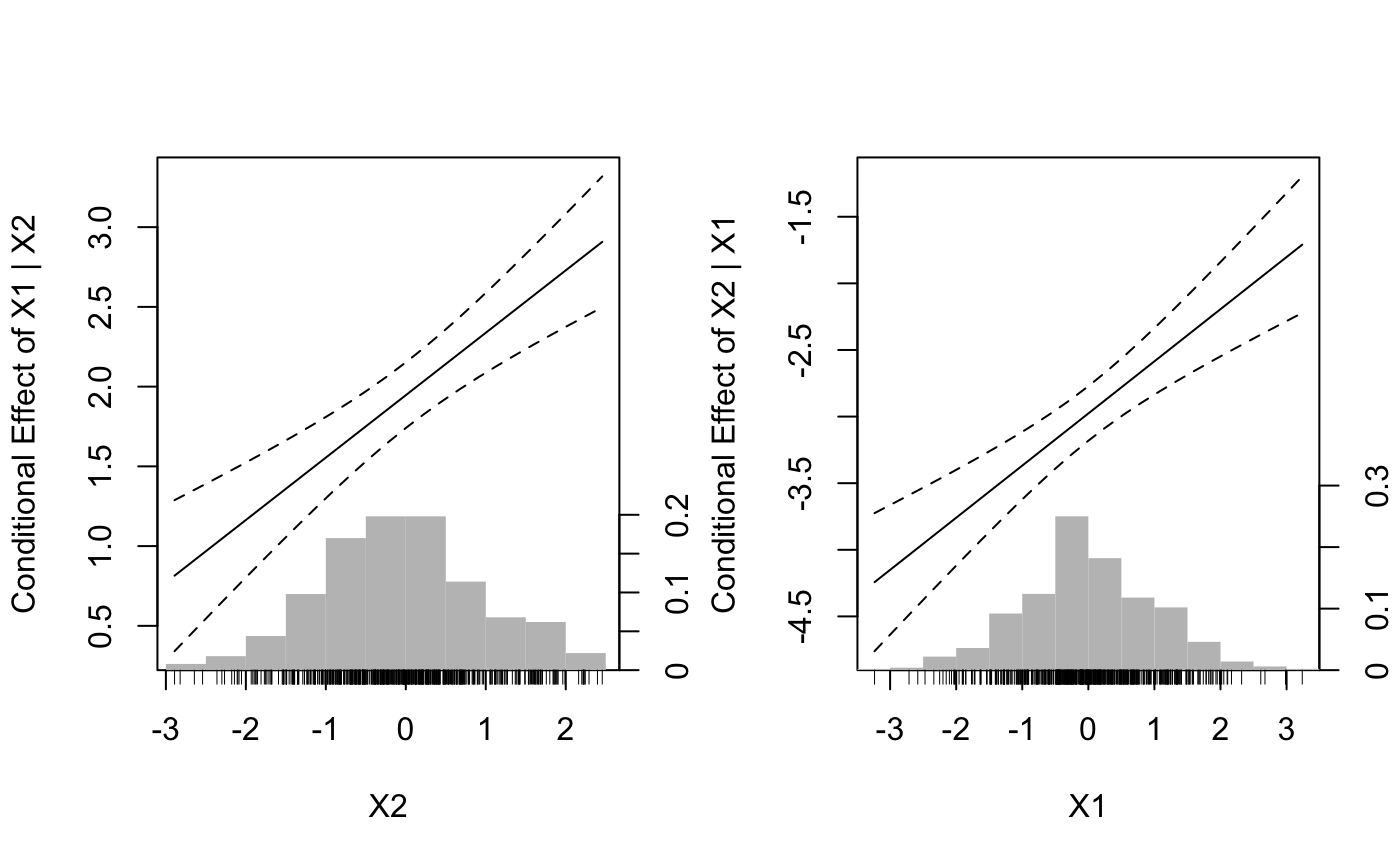Conditional Effects Plots for Interactions in Linear Models
DAintfun2.RdGenerates two conditional effects plots for two interacted continuous covariates in linear models.
DAintfun2( obj, varnames, varcov = NULL, rug = TRUE, ticksize = -0.03, hist = FALSE, hist.col = "gray75", nclass = c(10, 10), scale.hist = 0.5, border = NA, name.stem = "cond_eff", xlab = NULL, ylab = NULL, plot.type = "screen" )
Arguments
| obj | A model object of class |
|---|---|
| varnames | A two-element character vector where each element is the name of a variable involved in a two-way interaction. |
| varcov | A variance-covariance matrix with which to calculate the
conditional standard errors. If |
| rug | Logical indicating whether a rug plot should be included. |
| ticksize | A scalar indicating the size of ticks in the rug plot (if included) positive values put the rug inside the plotting region and negative values put it outside the plotting region. |
| hist | Logical indicating whether a histogram of the x-variable should be included in the plotting region. |
| hist.col | Argument to be passed to |
| nclass | vector of two integers indicating the number of bins in the
two histograms, which will be passed to |
| scale.hist | A scalar in the range (0,1] indicating how much vertical space in the plotting region the histogram should take up. |
| border | Argument passed to |
| name.stem | A character string giving filename to which the appropriate extension will be appended |
| xlab | Optional vector of length two giving the x-labels for the two
plots that are generated. The first element of the vector corresponds to
the figure plotting the conditional effect of the first variable in
|
| ylab | Optional vector of length two giving the y-labels for the two
plots that are generated. The first element of the vector corresponds to
the figure plotting the conditional effect of the first variable in
|
| plot.type | One of ‘pdf’, ‘png’, ‘eps’ or
‘screen’, where the one of the first three will produce two graphs
starting with |
Value
Either a single graph is printed on the screen (using
par(mfrow=c(1,2))) or two figures starting with name.stem are
produced where each gives the conditional effect of one variable based on
the values of another.
Details
This function produces graphs along the lines suggested by Brambor, Clark
and Golder (2006) and Berry, Golder and Milton (2012), that show the
conditional effect of one variable in an interaction given the values of the
conditioning variable. This is an alternative to the methods proposed by
John Fox in his effects package, upon which this function depends
heavily.
Specifically, if the model is
$$y_{i} = b_{0} +
b_{1}x_{i1} + b_{2}x_{i2} + b_{3}x_{i1}\times x_{i2} + \ldots + e_{i},$$
this function plots
calculates the conditional effect of \(X_{1}\) given
\(X_{2}\)
$$\frac{\partial y}{\partial X_{1}} = b_{1} +
b_{3}X_{2}$$ and the variances of the conditional
effects
$$V(b_{1} + b_{3}X_{2}) = V(b_{1} + X_{2}^{2}V(b_{3}) +
2(1)(X_{2})V(b_{1},b_{3}))$$ for different values of \(X_{2}\) and then
switches the places of \(X_{1}\) and \(X_{2}\), calculating the
conditional effect of \(X_{2}\) given a range of values of
\(X_{1}\). 95% confidence bounds are then calculated and plotted for
each conditional effects along with a horizontal reference line at 0.
References
Brambor, T., W.R. Clark and M. Golder. (2006) Understanding
Interaction Models: Improving Empirical Analyses. Political Analysis 14,
63-82.
Berry, W., M. Golder and D. Milton. (2012) Improving Tests of
Theories Positing Interactions. Journal of Politics.
Examples
data(InteractionEx) mod <- lm(y ~ x1*x2 + z, data=InteractionEx) DAintfun2(mod, c("x1", "x2"), hist=TRUE, scale.hist=.3)
